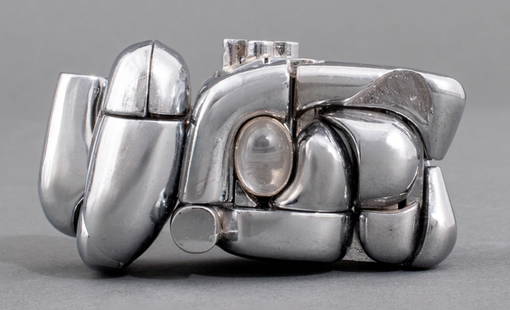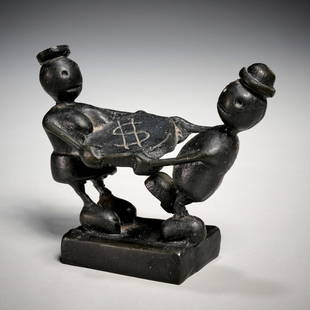
A Crossriver Stone Head, "akwanshi"
Similar Sale History
View More Items in BustsRelated Busts
More Items in Tribal Art Busts
View MoreRecommended Sculptures & Carvings
View More




















Item Details
Description
Stein-Kopf, "akwanshi"
Crossriver, Nigeria
Mit Sockel / with base
Stein. H 32,5 cm.
Provenienz:
- Galerie von Schroeder, Ulrich von Schröder, Zürich (1972).
- Rudolf und Leonore Blum (1919-2009 / 1923-2013), Zumikon.
Publiziert:
Blum, Rudolf (1995). Skulpturen alter Kulturen Afrikas aus der Sammlung Blum. Zumikon: Eigenverlag. Nr. 1.
Die Beschreibung von Ulrich von Schroeder (1972) wird dem Käufer ausgehändigt.
Dieser Kopf gehört in die Gruppe der Skulpturen, die im Gebiet um Ikom (Cross River State, Nigeria) von den dort heute ansässigen Ekoi vorgefunden wurden.
An mehreren Orten wurden Gruppen von Monolithe gefunden, die meisten aus Basalt, männlich, zwischen einem halben bis zu mehreren Metern hoch und im Kreis angeordnet. Die meist phallisch konzipierten, anthropomorphen Figuren werden lokal akwanshi (= toter Mensch in der Erde) oder atal (= Stein) oder alaptal (= langer Stein) genannt.
Laut mündlicher Überlieferung der heute in diesem Gebiet ansässigen Ekoi stammen diese Steine von ihren Vorfahren. Die Steine kämen aus den Flüssen deren Wasser sie glatt geschliffen hatte. Jeder Monolith und Stein stellt nach ihrer Auffassung einen Ahnen dar, dessen Name aber nicht bekannt ist.
Die Theorien über Verwendung und Ursprung dieser unverwechselbaren Zeugnisse einer vergangenen Kultur bleiben Vermutungen. Die einzige Referenz zu ihrem Entstehungszeitpunkt sind archäologische Fundstättenuntersuchungen, die ein Alter von etwa 1800 Jahren bezeugen.
Weiterführende Literatur:
Allison, Philip (1968). Cross River Monoliths. Lagos: Department of Antiquities.
---------------------------------------------------------------
Ulrich von Schroeder hat diese Arbeit wie folgt beschrieben: "Die Akwanshi- Steinfiguren stammen aus dem Gebiet der Ekoi, in der Gegend des Cross-Rivers, in Südost-Nigeria.
Die wohl zur Erinnerung an bedeutende Persönlichkeit en erstellten, phallusförmigen Monolithen, wurden erstmals im Jahr 1905 von einem englischen Offizier, tief im Urwald, in der Nähe \·an verlassenen Dörfern entdeckt.
Die heute in diesem Gebiet lebenden Stämme meid en diese Gegenden und können auch keine Hinweise über Alter und Bedeutung dieser "Akwanshi" geben. Man kann jedoch ein Alter von über 100 Jahren als sicher annehmen, da die traditionelle Schnitzkunst der in dieser Gegend lebenden Ekoi, keinerlei Ähnlichkeiten aufzuweisen hat.
Bei der vorliegenden Skulptur handelt es sich um den Kopfteil einer vor langer Zeit zerbrochenen Akwanshi, der ausgehöhlt wurde, um ihn einem anderen phallusförmigen Stein aufzusetzen."
---------------------------------------------------------------
Ekpo Eyo schreibt in "Africa The Art of a Continent" (Phillips, Tom (1995). Africa. The Art of a Continent. München: Prestel Verlag. Seiten.374-5) zu den Monolithen:
"These columnar basaltic stones on which human features were carved come from the basin of the Cross River or its tributaries. They are found almost exclusively within the five village groups of Nnam, Nselle, Abanyom, Nde and Akaju, who inhabit an area of over 900 sq. km in the middle of the Cross River area. Together, these villages form a homogenous linguistic group known as 'Bakor'. The Bakor language is a sub-dialect of the larger linguistic group known as Ekoi or Ejagham. The Ekoi or Ejagham are found in the easternmost part of southern Nigeria and in the contiguous area of the western Cameroon Republic.... Because these monoliths are almost exclusively found in the Bakor linguistic area, the term 'Bakor' is used here to refer to them (rather than 'Ekoi' or 'Cross River', terms that are too imprecise because they refer to a much wider and more diffuse geographical area than is relevant to these stones)".
---------------------------------------------------------------
Auf der sehr empfehlenswerten Online-Seite des Metropolitan Museum of Art (https://www.metmuseum.org/) ist zu einem solchen Steinkopf (Inv. Nr. 1995.64.18)folgendes zu lesen:
"Over 300 monoliths carved from basalt in this style were created in the Cross River region of Nigeria between 200 to 1900 A.D. These lithic monuments, which vary in size ranging from around two to over six feet in height, are usually found in circular groupings facing inward. The depiction of human features in stone is unusual in sub-Saharan Africa; additionally, the scale, number, and arrangement of the Cross River monoliths distinguish them from other groupings of anthropomorphic sculpture.
This particular example, with its elegant low-relief detailing around the eyes and the ornate cicatrization along the cheeks, led to its attribution to a class of objects created by members of the Nnam, one of eight clans that comprise the Bakor ethnic group of the Cross River region. Frequent motifs that appear on Nnam-style monoliths include a single spiral, double spiral, concentric circle, diamond, and triangle. This work is fragmentary and is the top half of what was originally a taller monolith. There is a clear differentiation between the sculpture's front and back, with the rear being devoid of inscription. The marks themselves refer to cicatrization patterns, which comment upon the wearer's level of initiation, ethnic, clan, and family identity. These markings may also relate to symbols that would have been painted on the body during festivals and ceremonies. All of the stones depict bearded figures, which suggest venerability and wisdom.
Though these objects have played an important role in the ritual life of successive generations of members of local communities, their original purposes can only be conjectured. They may represent the spirit of deceased ancestors. It is also possible that they were created as memorials to important political and historical figures. Local people maintain that the stones were created by otherworldly powers and emerged out of the ground like trees. The difficulty that carving and transporting these stones would have represented to their makers—as compared to wood, which would have been more easily available and workable—is a further indication of their importance."
---------------------------------------------------------------
Please feel free to contact us for all questions you might have regarding this lot (translations, additional views, condition report etc.).
CHF 7 000 / 14 000
EUR 6 370 / 12 740
Crossriver, Nigeria
Mit Sockel / with base
Stein. H 32,5 cm.
Provenienz:
- Galerie von Schroeder, Ulrich von Schröder, Zürich (1972).
- Rudolf und Leonore Blum (1919-2009 / 1923-2013), Zumikon.
Publiziert:
Blum, Rudolf (1995). Skulpturen alter Kulturen Afrikas aus der Sammlung Blum. Zumikon: Eigenverlag. Nr. 1.
Die Beschreibung von Ulrich von Schroeder (1972) wird dem Käufer ausgehändigt.
Dieser Kopf gehört in die Gruppe der Skulpturen, die im Gebiet um Ikom (Cross River State, Nigeria) von den dort heute ansässigen Ekoi vorgefunden wurden.
An mehreren Orten wurden Gruppen von Monolithe gefunden, die meisten aus Basalt, männlich, zwischen einem halben bis zu mehreren Metern hoch und im Kreis angeordnet. Die meist phallisch konzipierten, anthropomorphen Figuren werden lokal akwanshi (= toter Mensch in der Erde) oder atal (= Stein) oder alaptal (= langer Stein) genannt.
Laut mündlicher Überlieferung der heute in diesem Gebiet ansässigen Ekoi stammen diese Steine von ihren Vorfahren. Die Steine kämen aus den Flüssen deren Wasser sie glatt geschliffen hatte. Jeder Monolith und Stein stellt nach ihrer Auffassung einen Ahnen dar, dessen Name aber nicht bekannt ist.
Die Theorien über Verwendung und Ursprung dieser unverwechselbaren Zeugnisse einer vergangenen Kultur bleiben Vermutungen. Die einzige Referenz zu ihrem Entstehungszeitpunkt sind archäologische Fundstättenuntersuchungen, die ein Alter von etwa 1800 Jahren bezeugen.
Weiterführende Literatur:
Allison, Philip (1968). Cross River Monoliths. Lagos: Department of Antiquities.
---------------------------------------------------------------
Ulrich von Schroeder hat diese Arbeit wie folgt beschrieben: "Die Akwanshi- Steinfiguren stammen aus dem Gebiet der Ekoi, in der Gegend des Cross-Rivers, in Südost-Nigeria.
Die wohl zur Erinnerung an bedeutende Persönlichkeit en erstellten, phallusförmigen Monolithen, wurden erstmals im Jahr 1905 von einem englischen Offizier, tief im Urwald, in der Nähe \·an verlassenen Dörfern entdeckt.
Die heute in diesem Gebiet lebenden Stämme meid en diese Gegenden und können auch keine Hinweise über Alter und Bedeutung dieser "Akwanshi" geben. Man kann jedoch ein Alter von über 100 Jahren als sicher annehmen, da die traditionelle Schnitzkunst der in dieser Gegend lebenden Ekoi, keinerlei Ähnlichkeiten aufzuweisen hat.
Bei der vorliegenden Skulptur handelt es sich um den Kopfteil einer vor langer Zeit zerbrochenen Akwanshi, der ausgehöhlt wurde, um ihn einem anderen phallusförmigen Stein aufzusetzen."
---------------------------------------------------------------
Ekpo Eyo schreibt in "Africa The Art of a Continent" (Phillips, Tom (1995). Africa. The Art of a Continent. München: Prestel Verlag. Seiten.374-5) zu den Monolithen:
"These columnar basaltic stones on which human features were carved come from the basin of the Cross River or its tributaries. They are found almost exclusively within the five village groups of Nnam, Nselle, Abanyom, Nde and Akaju, who inhabit an area of over 900 sq. km in the middle of the Cross River area. Together, these villages form a homogenous linguistic group known as 'Bakor'. The Bakor language is a sub-dialect of the larger linguistic group known as Ekoi or Ejagham. The Ekoi or Ejagham are found in the easternmost part of southern Nigeria and in the contiguous area of the western Cameroon Republic.... Because these monoliths are almost exclusively found in the Bakor linguistic area, the term 'Bakor' is used here to refer to them (rather than 'Ekoi' or 'Cross River', terms that are too imprecise because they refer to a much wider and more diffuse geographical area than is relevant to these stones)".
---------------------------------------------------------------
Auf der sehr empfehlenswerten Online-Seite des Metropolitan Museum of Art (https://www.metmuseum.org/) ist zu einem solchen Steinkopf (Inv. Nr. 1995.64.18)folgendes zu lesen:
"Over 300 monoliths carved from basalt in this style were created in the Cross River region of Nigeria between 200 to 1900 A.D. These lithic monuments, which vary in size ranging from around two to over six feet in height, are usually found in circular groupings facing inward. The depiction of human features in stone is unusual in sub-Saharan Africa; additionally, the scale, number, and arrangement of the Cross River monoliths distinguish them from other groupings of anthropomorphic sculpture.
This particular example, with its elegant low-relief detailing around the eyes and the ornate cicatrization along the cheeks, led to its attribution to a class of objects created by members of the Nnam, one of eight clans that comprise the Bakor ethnic group of the Cross River region. Frequent motifs that appear on Nnam-style monoliths include a single spiral, double spiral, concentric circle, diamond, and triangle. This work is fragmentary and is the top half of what was originally a taller monolith. There is a clear differentiation between the sculpture's front and back, with the rear being devoid of inscription. The marks themselves refer to cicatrization patterns, which comment upon the wearer's level of initiation, ethnic, clan, and family identity. These markings may also relate to symbols that would have been painted on the body during festivals and ceremonies. All of the stones depict bearded figures, which suggest venerability and wisdom.
Though these objects have played an important role in the ritual life of successive generations of members of local communities, their original purposes can only be conjectured. They may represent the spirit of deceased ancestors. It is also possible that they were created as memorials to important political and historical figures. Local people maintain that the stones were created by otherworldly powers and emerged out of the ground like trees. The difficulty that carving and transporting these stones would have represented to their makers—as compared to wood, which would have been more easily available and workable—is a further indication of their importance."
---------------------------------------------------------------
Please feel free to contact us for all questions you might have regarding this lot (translations, additional views, condition report etc.).
CHF 7 000 / 14 000
EUR 6 370 / 12 740
Buyer's Premium
- 26% up to CHF 100,000.00
- 21% above CHF 100,000.00
A Crossriver Stone Head, "akwanshi"
Estimate CHF 7,000 - CHF 14,000
16 bidders are watching this item.
Shipping & Pickup Options
Item located in Basel, Basel, chOffers In-House Shipping
Local Pickup Available
Payment

HAMMER AUKTIONEN, African, Tribal, Oceanic, Asian, Ancient Art
Basel, Switzerland1,531 Followers
Auction Curated By

African and Oceanic Art
TOP





































































